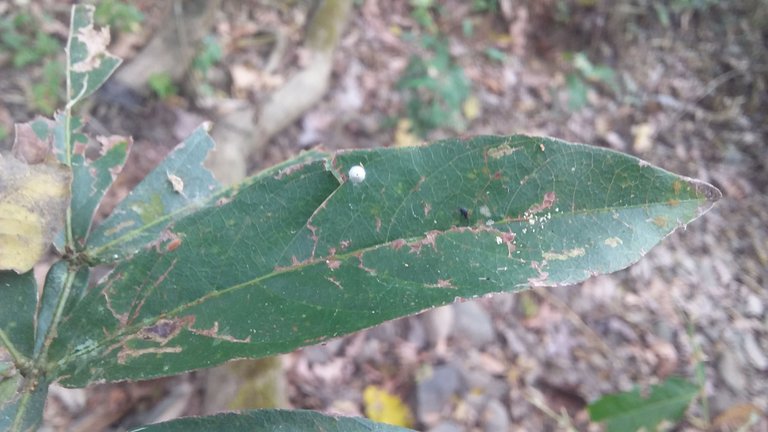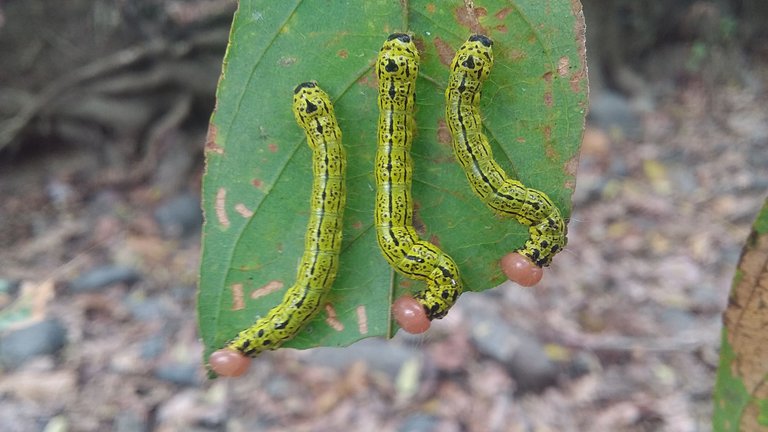
Parece un día tranquilo para observar a esta hoja; su nervio central alargado por una línea que une los bordes y los delimita en dos mitades. ¡Pero cuidado! porque aunque el haz se vea limpio de peligro, aún no hemos visto su envés y no sabemos con qué sorpresa nos podemos topar.
It seems a calm day to observe this leaf; its central nerve elongated by a line that joins the edges and delimits them in two halves. But be careful! because although the beam looks clean of danger, we have not yet seen its underside and we do not know what surprise we may encounter.

Pero primero observemos este especie de capullo que indica que algo anda cerca, porque aunque forman parte de la naturaleza; los capullos son señales particulares de una de las peores plagas de las plantas.
But first let's look at this type of silk that indicates that something is near, because although they are part of nature; silk is a particular sign of one of the worst plant pests.

¡Ajá!, volvemos a observar a una de las hojas y vean que un punto rojo se asoma por el ápice, bueno, lo queda de él. Pero, ¿qué será lo que se esconde en el envés? ¿Cuál es el misterio de las hojas ruñidas?
Aha, we look again at one of the leaves and see a red dot peeking out of the apex, well, what's left of it. But what is hidden on the underside of the leaf? What is the mystery of the modid leaves?

Ahí está, un peligroso depredador de plantas. Si lo miran bien notarán su belleza; un metazoo, un invertebrado de vida libre que se está dando un banquete.
There it is, a dangerous plant predator. If you look closely you will notice its beauty; a metazoan, a free-living invertebrate feasting.

Observen cómo este parásito de cuerpo blando arrasa con la hoja, va dejando el tallo, del que se diferencia por su color, y sus pintas que forman una línea negra y en particular por su cabeza rosada.
Observe how this soft-bodied parasite sweeps away the leaf and leaves the stem, from which it differs by its color, its black spots forming a black line, and in particular by its pink head.

Pero no es uno el que devora a la planta, son varios; distribuidos por todas las ramas hacen el trabajo de desnudarla y dejarla a la intemperie del clima.
But it is not one that devours the plant, but several; distributed throughout the branches, they do the job of stripping the plant and leaving it out in the open.

Vean, aquí hay dos más; silenciosos, mortales, impertérritos ante cualquier presencia. Están en lo que mejor saben: comer, para eso han venido al mundo, por eso son parásitos, pero cuya presencia nutre la vida de la flora y la fauna de una región.
See, here are two more; silent, deadly, undaunted by any presence. They are doing what they do best: eating, that's why they came into the world, that's why they are parasites, but whose presence nourishes the life of the flora and fauna of a region.

Aquí parece que posan para mi cámara; pero es mentira, porque aunque se ven en la altura, ellos no diferencian su posición; solo están allí para decirle a la naturaleza que existen para equilibrar los nichos ecológicos y que si su trabajo es comer, pues no es su culpa que le hayan asignado esa responsabilidad.
Here it looks like they are posing for my camera; but it is a lie, because although they are seen at altitude, they do not differentiate their position; they are only there to tell nature that they exist to balance the ecological niches and that if their job is to eat, it is not their fault that they have been assigned that responsibility.

He aquí sus mejores poses; de dos y de tres se juntan, no para sonreír ni para presumir su belleza; se juntan porque así acaban más rápido la cena.
Here are their best poses; two by two and three by three they come together, not to smile or to show off their beauty; they come together to finish dinner first.


Y así dejan las ramas; sin hojas y sin nada.
And so they leave the branches; leafless and bare.

Texto y fotografías de: Text and photographs by:
@jesuspsoto



